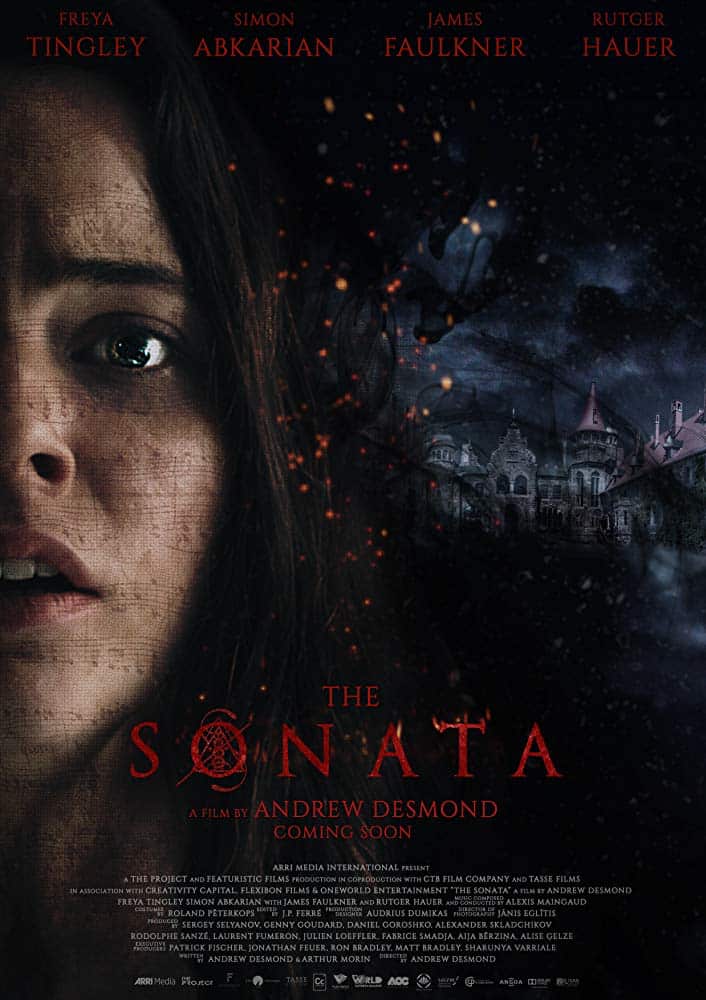★★★★1/2 out of ★★★★★
A beautifully shot Lovecraftian tale of classical music and madness.
Directed by Andrew Desmond.

Secret societies. Diabolical codes. A centuries old manor house. Nightmares. Ghosts. Madness. Death. Whip these ingredients together; add a dash of foreboding, a pinch of fearful villagers, and you’ve got yourself a modern masterpiece of Gothic horror.
With his feature film debut, writer/director Andrew Desmond relies on brooding atmosphere and deliberate pacing instead of gallons of red dye and Karo syrup. Not that there’s anything wrong with vats of fake blood, of course. People working in the fake blood factories need to be able to feed their families, too. Once in a while, though, it’s nice to feast on something different.
The Sonata — which had its U.S. premiere at this year’s Popcorn Frights Film Festival — starts out with a clever POV sequence of eccentric, reclusive composer Richard Marlowe [legendary genre favorite Rutger Hauer; may he rest in peace] putting the final touches on his most recent composition. Having completed the score, ol’ Mr. Marlowe has a drink, and… let’s just say… shuffles off this mortal coil in a rather flamboyant manner.

Later, we catch up with violinist extraordinaire Rose Fisher [Freya Tingley; TV’s Hemlock Grove (2013)] as she’s recording tracks for her upcoming album. During a break, her agent, Charles Vernais [Simon Abkarian; Casino Royale (2006)], has the unenviable duty of telling Rose that her estranged father has died. In their subsequent visit to the lawyer’s office, Rose finds out that she’s his only heir and has inherited everything: the home in France, the artwork, and as she soon discovers… The Sonata.
First and foremost, in a movie about classical music you’d expect there to be some top notch compositions. The Sonata and its award winning French composer Alexis Maingaud do not disappoint. Not only is the score wonderfully done, but The Sonata itself is an interesting piece of music. Freya Tingley took violin lessons in preparation for this project so she could at least look like she knew what she was doing, but all of the heavy lifting was handled by her “Violin Double,” Alina Vasiljeva.

Another stand out for this movie is Janis Eglitis’ cinematography. From gloomy forests and dilapidated chapels to glamorous concert halls and luxurious fires in the stately manor’s main room, each location is beautifully shot and resonates with its own character.
Writing credit for The Sonata is shared between Andrew Desmond and first time writer Arthur Morin. The script is tight, the dialog believable, and everything flows along without a sour note. Pacing for the film is excellent, but keep in mind that this is not what you’d call an action movie. This is a well-crafted mystery that unfolds in its own time.

Freya Tingley and Simon Abkarian are phenomenal in this movie. They play the hopeful mentor vs. frustrated pupil dynamic perfectly and have very good on screen chemistry in a father/daughter kind of way. This makes things even more unsettling as Abkarian’s character, Charles, slowly loses his marbles. Plus, with Tingley coming in at a petite 5’2″ tall (about 157cm), the director was able to set up some rather dramatic scenes between her and Abkarian. I’m not sure how tall he is, but he towered over his co-star whenever they stood together.
The other notable performance comes from industry veteran James Faulkner [Randyll Tarly in HBO’s Game of Thrones (2016-2017)] as historian and musicologist Sir Victor Ferdinand. Faulkner brings a weight to the production that would have been sorely missing without him.

And then there are the special effects.
There aren’t a ton of them in The Sonata. Or, at least, most of the ones you see are pretty subtle. Truth be told, I wish they’d stuck to the “less is more” doctrine for the whole film. As a Gothic tale, the audience doesn’t necessarily need to see everything. Howard P. Lovecraft was notorious for his non-descriptive descriptions and this movie is so Lovecraft-adjacent that method would have fit right in.
Unfortunately, the decision was made to throw in some CG effects to the climactic scene near the end of the film and that was the wrong choice. Instead of evoking shades of Lovecraft’s “The Music of Erich Zann” (1922) as it did to such great effect throughout the bulk of the movie, the CG effects were wince-inducingly similar to a Scooby Doo cartoon. I half expected Fred and Velma to jump out of the Mystery Machine and reveal it had just been Old Man Weatherby from the amusement park this whole time.

After thoroughly enjoying the entire movie up to that point, it was a bit of a let down. However, The Sonata got half a star back for not ending the movie on such a Hanna-Barbera note. The final scene of the film wrapped things up with the same atmospheric elegance it had before it took a stumbling waltz down CGI Lane.
Aside from the disastrous CGI (which we’re just going to pretend never happened and shall never speak of again), The Sonata is a gorgeous Gothic mystery with stellar performances backed by a fantastic story reminiscent of Carpenter’s In the Mouth of Madness (1994). Just using classical music as the vehicle instead of horror novels. For fans of thoughtful, ominous movies, The Sonata is a must-see.
Just keep a firm grip on your sanity.
If you missed The Sonata at Popcorn Frights, it will be playing September 8th at the FilmQuest Festival in Provo, Utah.
Review by Robert Zilbauer.


